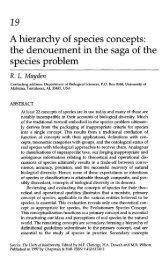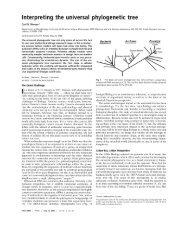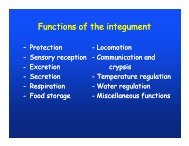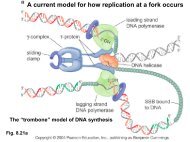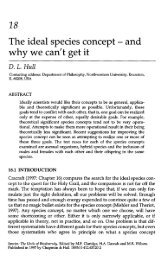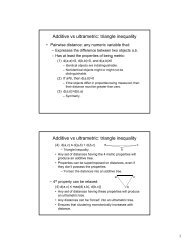3. Basic probability concepts
3. Basic probability concepts
3. Basic probability concepts
You also want an ePaper? Increase the reach of your titles
YUMPU automatically turns print PDFs into web optimized ePapers that Google loves.
Value of first die<br />
Value of second die 1 2 3 4 5 6<br />
1 2 3 4 5 6 7<br />
2 3 4 5 6 7 8<br />
3 4 5 6 7 8 9<br />
4 5 6 7 8 9 10<br />
5 6 7 8 9 10 11<br />
6 7 8 9 10 11 12<br />
The table shows that there are 36 possible outcomes, four of which result in a sum of 5 for the<br />
two dice. If the dice are fair then all 36 outcomes are equally likely to occur, and the <strong>probability</strong><br />
of a 5 on one throw of two fair die is 4/36, or approximately 0.11. The most likely outcomes<br />
from throwing two dice simultaneously are sums of either 6 or 7; both outcomes have<br />
probabilities of 6/36 = 1/6, or approximately 0.17. Since there is only one way to throw a sum of<br />
12 (=6+6), its <strong>probability</strong> is 1/36, or approximately 0.0<strong>3.</strong><br />
These examples suggest a general definition for classical <strong>probability</strong>:<br />
The classical <strong>probability</strong> of an outcome is the number of ways that outcome can occur,<br />
relative to the total number of ways that all outcomes of an event can be generated.<br />
Or, more concisely,<br />
Pr ( outcome)<br />
number of ways outcome can occur<br />
=<br />
number of ways all outcomes can occur<br />
where Pr( outcome ) is read as “the <strong>probability</strong> of the outcome”. If we call a particular outcome<br />
A, this can be written as<br />
nA ( )<br />
Pr( A)<br />
= .<br />
n<br />
The most common use of classical probabilities in statistics is to serve as null hypotheses.<br />
For example, when we flip a fair coin, the <strong>probability</strong> of observing a head is the same as the<br />
<strong>probability</strong> of a tail; both are ½. If we have reason to believe that the coin is not fair, the<br />
assumption of fairness is translated into a null hypothesis of equal <strong>probability</strong>, which can then be<br />
tested using empirical probabilities (described in the following section). In an ecological study<br />
of predator behavior in which the predator has four potential prey species, an initial and<br />
simplistic null hypothesis might be that the prey species are equally likely to be selected by the<br />
predator, each with a <strong>probability</strong> of ¼. This can be tested using empirical probabilities.<br />
Empirical probabilities<br />
Empirical probabilities are values derived by sampling, and are based on the concept of<br />
long-run or asymptotic relative frequency. The relative frequency of a particular outcome is the<br />
5



